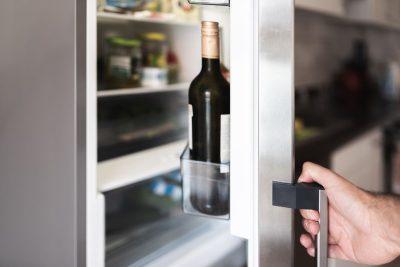Are you wondering whether should red wine be refrigerated or not? It’s a common question among wine enthusiasts, as many believe that storing red wine in a refrigerator can affect its taste and quality. In this article, we’ll explore the answer to this question and provide you with the information you need to make an informed decision.
It is recommended to refrigerate red wine to preserve its flavor and quality, but it should be brought to room temperature before serving. It is important to note that red wine should not be stored in the refrigerator for too long as it can affect the taste and texture of the wine.
It is best to consume it within a few days after opening, or if you are storing it for a long time, then it is advisable to keep it in a cool, dark place.
Should red wine be refrigerated?
Red wine should not be refrigerated for long-term storage. Red wine is best stored at a consistent temperature between 55-68°F, which is considered the ideal range for aging and storing red wine. This temperature range can be achieved in a wine cellar or a red wine fridge specifically designed for aging wine.
Storing red wine in a regular kitchen refrigerator can be detrimental to the wine as the temperature fluctuates every time the door is opened and closed. Additionally, the humidity level inside a regular refrigerator is usually too low, which can dry out the cork and allow air into the bottle, causing the wine to oxidize.
However, it’s perfectly fine to refrigerate a bottle of red wine for a short period of time before serving it, especially if the wine is too warm. Red wine should be served at a cooler temperature than room temperature, around 60-65°F; this will help to bring out its full flavor and aroma.
Furthermore, red wine should not be refrigerated for long-term storage, but it can be refrigerated for a short period of time before serving to achieve the optimal serving temperature. To store and age red wine properly, it’s recommended to use a red wine fridge or a wine cellar with the appropriate temperature and humidity levels.
Is it necessary to refrigerate red wine before serving?
It is not necessary to refrigerate red wine before serving, but it is recommended to bring it to room temperature before consuming. This is because red wine that is too cold can have a muted flavor and aroma.
It is best to remove the bottle from the refrigerator about 30 minutes to an hour before serving to allow it to reach the optimal temperature for drinking. However, if you prefer your red wine chilled, it can be kept in the refrigerator until ready to serve.
What are the ideal storage conditions for red wine?
The ideal storage conditions for red wine are cool, dark, and consistent temperatures. Here are a few key points to keep in mind:
- Temperature: The ideal temperature range for red wine storage is between 55-60°F (13-15°C). This is because temperatures above 70°F (21°C) can cause the wine to age too quickly, while temperatures below 50°F (10°C) can cause the wine to become too cold, affecting its flavor and aroma.
- Humidity: Red wine should be stored in an environment with a relative humidity of around 70%. This is because too much humidity can cause mold growth, while too little humidity can dry out the cork, allowing air to enter the bottle and oxidize the wine.
- Light: Red wine should be stored in a dark place, as light can damage the wine and cause it to spoil. This is because light can cause the wine to heat up and can also cause the wine to become oxidized, which can affect the flavor and aroma.
- Vibration: Red wine should be stored in a place that is free from vibrations. Vibrations can cause the wine to move and stir up the sediment, which can affect the flavor and aroma of the wine.
- Orientation: It is recommended to store red wine bottles horizontally; this will help keep the cork moist and will prevent the wine from coming into contact with the air, which could spoil the wine.
- Consistency: Storing red wine in consistent conditions is important to avoid fluctuations in temperature and humidity that can cause the wine to spoil.
By keeping these conditions in mind and providing a consistent environment, the red wine will be stored in the best possible condition, ensuring that the wine will taste as it should when it is finally opened and consumed.
How does refrigeration affect the taste of red wine?
Refrigeration can affect the taste of red wine in several ways:
- Temperature: Red wine is best served at room temperature, which is around 60-65°F (15-18°C). If red wine is too cold, it can dull the flavors and aromas, making it less enjoyable to drink.
- Tannins: Tannins are compounds found in red wine that give it a dry, bitter taste. When red wine is chilled, tannins can become more pronounced, making the wine taste more astringent.
- Acidity: Red wine is naturally acidic, and refrigeration can cause acidity levels to become more pronounced, making the wine taste sharper and less balanced.
- Aroma: The aroma of red wine is an important part of the overall drinking experience. When red wine is chilled, the aroma becomes less pronounced, making it less enjoyable to drink.
- Flavor: The flavor of red wine can be affected by refrigeration. The wine can become more muted, and less complex, making it less enjoyable to drink.
Additionally, refrigeration can be beneficial for red wine if it’s opened and not consumed within a few days; in that case, it can help preserve the wine’s flavors and aromas. But if you’re planning on serving red wine, it’s best to remove it from the refrigerator a few minutes before serving; this will help it to reach room temperature and will bring out its best flavors.
Can refrigeration damage red wine?
Refrigeration can damage red wine if it is stored at temperatures below its ideal range. Red wine is best stored at temperatures between 55-65°F (13-18°C). If it is stored at temperatures below this range, it can cause the wine to become too cold, which can cause the tannins to become harsh and the flavors to become muted.
Additionally, if the wine is stored in the refrigerator for an extended period of time, it can cause the cork to dry out, which can allow air to enter the bottle and spoil the wine. Therefore, it is best to store red wine in a cool, dark place and only refrigerate it for a short period of time before serving.
How long can open red wine last in the refrigerator?
Opened red wine can last in the refrigerator for 3-5 days if it’s stored properly. You should transfer it to an airtight container, like a wine stopper or a vacuum pump, or seal the bottle with aluminum foil or plastic wrap to minimize the amount of air that comes into contact with the wine.
This will slow down the process of oxidation, which is the main cause of spoilage in opened wine bottles. Additionally, it’s important to store the wine in the refrigerator at a consistent temperature, between 45-50°F (7-10°C)
It’s important to note that even with proper storage, the wine will start to change and lose its flavor and aroma over time. The longer the wine is stored open in the refrigerator, the more pronounced these changes will be. So, it’s best to consume the wine within a few days of opening it.
How to properly store red wine in the refrigerator?
Properly storing red wine in the refrigerator involves several steps to ensure that the wine retains its flavor and aroma. Here are some tips on how to properly store red wine in the refrigerator:
- Keep the wine at the right temperature: Red wine should be stored in the refrigerator at a consistent temperature between 45-50°F (7-10°C). This is cooler than the ideal serving temperature for red wine, but it will help to slow down the process of oxidation, which can cause the wine to spoil.
- Use an airtight container: Once the wine is open, transfer it to an airtight container, such as a wine stopper or a vacuum pump, to minimize the amount of air that comes into contact with the wine. This will help to slow down the process of oxidation and prevent the wine from spoiling.
- Store the wine in the dark: Light can cause the wine to spoil, so it’s important to store the wine in the refrigerator in a dark place, such as the back of the refrigerator.
- Keep the wine on its side: Keeping the wine on its side will help to keep the cork moist, which will prevent air from entering the bottle and spoiling the wine.
- Consume the wine within a few days: Even with proper storage, the wine will start to change and lose its flavor and aroma over time. The longer the wine is stored open in the refrigerator, the more pronounced these changes will be. So, it’s best to consume the wine within a few days of opening it.
By following these tips, you can ensure that your red wine is stored properly in the refrigerator and retains its flavor and aroma for as long as possible.
What are the signs that red wine has gone bad?
Red wine can go bad due to a variety of reasons, including oxidation, spoilage, and improper storage. Knowing the signs that red wine has gone bad can help you determine whether or not it is safe to drink. Here are some of the most common signs that a bottle of red wine has gone bad:
- Foul odor: A strong, musty, or sour odor is a sign that the wine has gone bad. This is often caused by spoilage or bacteria growth.
- Cloudy appearance: A cloudy appearance can be a sign that the wine has spoiled. This can happen if the wine has been exposed to too much oxygen or if there is bacteria growth in the bottle.
- Flat or dull taste: A wine that tastes flat or dull is a sign that it has been exposed to too much oxygen, which can cause the flavors to become muted.
- Sour or vinegar-like taste: A sour or vinegar-like taste is a sign that the wine has gone bad. This can happen if the wine has been exposed to too much oxygen or if there is bacteria growth in the bottle.
- Presence of sediment: Red wine is known to have sediment, but an excessive amount can be a sign that the wine is no longer good to drink.
It’s important to note that not all of these signs will be present in every spoiled bottle of wine. If you notice any of these signs, it’s best to discard the bottle and not drink it.
Is it safe to drink red wine that has been refrigerated for too long?
It depends on how long the red wine has been refrigerated and the condition of the wine before it was refrigerated. If the wine has been refrigerated for a short period of time, such as a few days, and was stored properly in an airtight container at a consistent temperature between 45-50°F (7-10°C), it should be safe to drink.
However, if the wine has been refrigerated for an extended period of time or stored improperly, it may have developed off-flavors or odors, or the cork may have dried out, which can allow air to enter the bottle and spoil the wine. In this case, it is not recommended to drink the wine.
It’s also worth noting that even if the wine has been stored properly in the refrigerator, it will still change and lose its flavor and aroma over time, so it’s best to consume it within a few days of opening it.
Additionally, it is always a good idea to check the wine for signs of spoilage before consuming it, such as a strong, musty, or sour odor, cloudy appearance, flat or dull taste, sour or vinegar-like taste, or the presence of excessive sediment. If you notice any of these signs, it is best to discard the bottle and not drink it.
How does refrigeration change the aging process of red wine?
Refrigeration can slow down the aging process of red wine. Wine aging is a complex process that is influenced by various factors, including temperature, humidity, light, and the presence of oxygen.
When red wine is stored at a cool, consistent temperature between 55-65°F (13-18°C), the aging process proceeds at a moderate pace. The wine’s tannins and other chemical compounds slowly interact with each other, allowing the flavors and aromas to develop and mature.
However, when red wine is stored in the refrigerator at temperatures below this range, the aging process slows down significantly. The cool temperatures can cause the wine’s tannins to become harsher and the flavors to become muted.
Additionally, storing wine in the refrigerator for an extended period of time can cause the cork to dry out, which can allow air to enter the bottle and spoil the wine.
Therefore, it is worth noting that refrigeration does not stop the aging process, but it delays it. So, if a wine is stored in the refrigerator for a long period of time and is then taken out and brought to room temperature, it will continue to age, but it will have missed the aging process that would have happened if it was stored in the optimal temperature range.
How does refrigeration affect the color of red wine?
Refrigeration can affect the color of red wine by causing it to appear darker. This is because cool temperatures can cause the wine’s pigments to settle out of suspension, which makes the wine appear darker.
Additionally, the cool temperatures can cause the wine’s tannins to become more tightly bound, which can also contribute to the wine appearing darker.
Furthermore, you need to know that a darker color alone doesn’t mean that the wine is bad, but it could indicate that the wine has lost some of its youthful character and vibrancy. This can be caused by the wine being stored in the refrigerator for an extended period of time or by the wine being stored at temperatures that are too cold.
What are the pros and cons of refrigerating red wine?
Here are some pros and cons of refrigerating red wine:
Pros:
- Slows down the aging process: Refrigeration can slow down the aging process of red wine, which can help to preserve its flavor and aroma for a longer period of time.
- Reduces spoilage: Storing red wine in the refrigerator can help to reduce spoilage by slowing down the process of oxidation, which is the main cause of spoilage in opened wine bottles.
- Improves flavor: Some people prefer to drink red wine chilled; refrigeration can make the tannins less harsh and the flavors more pronounced.
Cons:
- Can cause damage: Refrigeration can damage red wine if it is stored at temperatures below its ideal range. This can cause the wine’s tannins to become harsh and the flavors to become muted.
- Can dry out the cork: If the wine is stored in the refrigerator for an extended period of time, it can cause the cork to dry out, which can allow air to enter the bottle and spoil the wine.
- Can change the color: Refrigeration can cause red wine to appear darker, which can be an indicator that the wine has lost some of its youthful character and vibrancy.
- Not ideal for aging: Long-term storage of red wine in the refrigerator is not ideal for aging, as it can delay the aging process and can cause the wine to lose some of its flavors and aromas.
Are there any types of red wines that should not be refrigerated?
Red wine is typically stored at a temperature between 55-60°F (13-15°C). It is generally not recommended to refrigerate red wine as it can cause the wine to become too cold, which can dull the flavors and aromas. Additionally, if the wine is exposed to temperature fluctuations, it can cause the wine to spoil.
However, there are some red wines that are meant to be served chilled, such as certain types of lighter-bodied reds like Beaujolais or Gamay. These wines are best served at a temperature between 45-55°F (7-13°C).
How to properly chill red wine before serving it?
Here are a few steps to properly chill red wine before serving it:
- Keep the wine in the refrigerator for about 30 minutes to an hour before serving. This will bring it to the appropriate serving temperature of around 55-60°F (13-15°C) for full-bodied reds.
- For lighter-bodied reds like Beaujolais or Gamay, you can chill them for a longer period of time or even put them in an ice bucket with ice and water for 20-30 minutes before serving.
- If you don’t have time to refrigerate the wine, you can also chill it quickly by placing the bottle in a bucket of ice and water for about 20-30 minutes.
- If you’re in a rush, you can also put the bottle in the freezer for about 15-20 minutes; just be careful not to freeze it.
- It’s important to note that you should never serve a red wine that is too cold, as it can dull the flavors and aromas.
- Finally, Once you’ve chilled the wine to the desired temperature, remove it from the refrigerator or ice bucket and let it sit for a few minutes to let it reach room temperature before serving.
Conclusion
Should red wine be refrigerated? Red wine should not be refrigerated as it can cause the wine to become too cold and dull the flavors and aromas. Red wine is typically stored at a temperature between 55-60°F (13-15°C).
However, there are some types of lighter-bodied red wines like Beaujolais or Gamay that are meant to be served chilled, which can be refrigerated for a short period of time before serving. It’s important to remember that once the wine has been chilled, it should be removed from the refrigerator or ice bucket and allowed to reach room temperature before serving.




